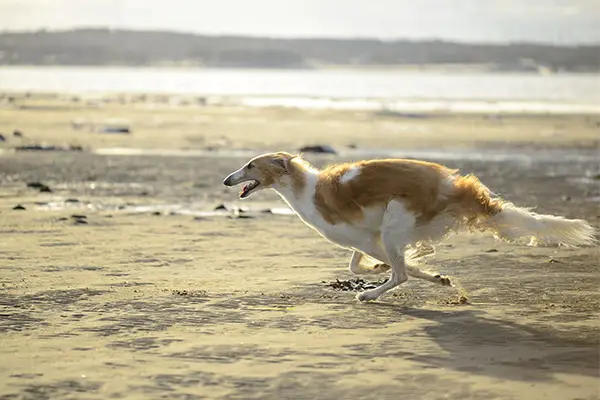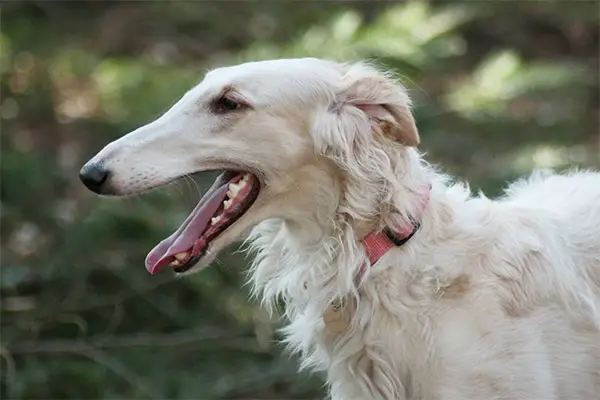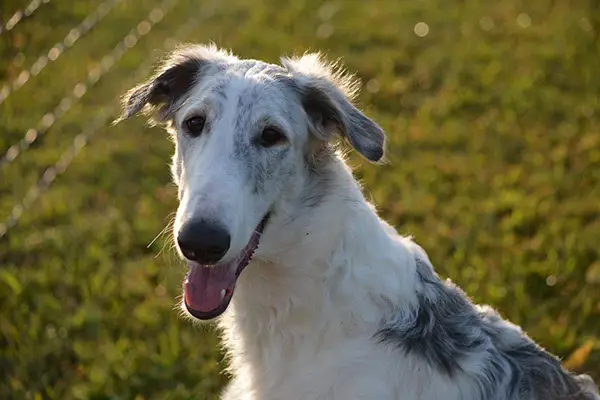Borzois are large and elegant dogs from the hound group. The Borzoi stands at the height of 28 inches, has a tall and lean body, and a narrow head. These dogs are often described as greyhounds covered with a silky coat. They are also known for their majestic appearance, agility, and grace.
Despite their looks, Borzois will not be an excellent fit for inexperienced owners. They can be stubborn, and they need someone who is always at home. With their size, they also need space and so may not be suitable in an apartment living. If you find yourself to be an excellent fit for a Borzoi dog, you might have found an excellent family friend who can be sweet and gentle.
Borzoi Breed Statistics
| Dog Breed Group | Hound |
| Breed Size | Large |
| Height | 28 inches & up (male); 26 inches & up (female) |
| Weight | 75-105 pounds (male); 60-85 pounds (female) |
| Lifespan | 7-9 years |
Borzoi Breed Ratings
| Energy level | |
| Exercise needs | |
| Requires attention | |
| Playfulness | |
| Trainability | |
| Shedding | |
| Grooming | |
| Friendly with family | |
| Friendly with kids | |
| Friendly with strangers | |
| Friendly with other dogs | |
| Prey Drive |
Borzoi History
The Borzoi’s history can be traced back to Russia, which is why they were formerly called Russian Wolfhounds. They were developed around 1650 when the Romanovs are ruling Russia.
During this time, wolf-hunting has been known to be part of the royal’s life, and so they created a dog that would accompany them in this activity.
The dog was developed to look like a greyhound. However, it must be covered with a thick coat that almost resembles that of the Russian sheepdog. It would also need to be strong and courageous. But most of all, it has to be beautiful.
The resulting dog was the Borzoi, and the Borzoi hunt was one of the grandest hunting events the nobles prepared. Russian aristocrats kept hundreds of these dogs in kennels. They were called the royal hunting companions.
However, when the Romanov family was slaughtered, the dogs were also killed as hated symbols of the Russian ruler. The numbers declined drastically and almost became extinct.
After the Revolution, English dog fanciers started importing Borzois to America. The American Kennel Club then recognized the breed by 1891. And several years later, in 1936, what was used to be called the Russian Wolfhound was finally named Borzoi.
Borzoi Temperament
The American Kennel Club describes Borzoi dogs as affectionate, loyal, and regally dignified dogs. Known to have an aristocratic background, these are gentle-spirited dogs. Their temperament can vary from being serious to being humorous.
Indoors, Borzois are known to be quiet and sensible dogs. They love the company of family and must never be left alone for long periods. When outdoors, Borzois love to be entertained. Like most hunting dogs, Borzois love to chase, so make sure to keep him in a fenced yard.
Although gentle with children, don’t let a Borzoi and a toddler stay in one room without supervision. These are large dogs, and they may accidentally knock out a small child. They are also better in a one-dog household as they can be very sensitive.
The Borzoi’s reaction to strangers varies from one dog to another. But most of them never react when a suspicious person comes into their territory. They may bark to let you know someone is there, but that’s it.
If you want to make them more well-rounded dogs, socialization and training are essential. Always remember to give firm and consistent leadership. These dogs are smart, but they can be stubborn, so make sure they know you’re in charge.

Borzoi Care Requirements
- Nutrition: Borzois are energetic dogs that need a high-quality and well-balanced meal to keep them healthy and happy. This should consist of all the essential nutrients: protein, fat, carbohydrate, vitamins, and minerals. There’s no special diet required; however, it’s best that you only buy high-quality ingredients. If you’re going to feed him dog food, but the premium quality ones. Borzois have sensitive stomachs, so it’s essential that what they eat doesn’t contain fillers and harmful additives that can affect digestion.
- Grooming: Borzois have long, silky coats that shed seasonally. It will need a once over brushing weekly, or daily when the shedding season comes. Brushing the coat is extremely important to remove dirt, debris, dead hair, mats, and tangles. Baths can be given regularly, probably once every four weeks, if you want your dog to look his best. Don’t forget to clean up the ears to prevent ear infection, and nails should be trimmed so as not to cause pain and discomfort to your dog.
- Exercise: Borzois are large energetic dogs who need their regular exercise. This can be in the form of long walks on-leash or running around a securely fenced yard. These dogs enjoy activities done together with their humans the most. So, create play sessions that will help stimulate his mind and body. You can also let him join canine events where he will be able to showcase his agility and grace.
- Health: Borzois are generally healthy dogs, but it’s essential to know what diseases affect them. You would need to watch three health conditions: gastric torsion, progressive retinal atrophy, and osteochondrosis dissecans. You must always provide your dog with the right care, food, and exercise to prevent these diseases. You can also meet one of your dog’s parents to know if there are genetically transmitted diseases that your dog might have. Always observe your dog’s behavior and take him for a check-up if you notice some changes. Screening tests are available too, so if you want to rule out any health condition, you might want to let your dog take one.
- Lifespan: The life expectancy of Borzois is 9-14 years.
Famous Borzois
- Elsie: The first Borzoi imported to the US
- Irma: The first Borzoi registered with the American Kennel Club
Fun Facts about Borzois
- Borzois originated from Russia around 1650.
- They were developed by the Russian aristocracy as companions in wolf hunting.
- They were originally called Russian Wolfhounds.
- Borzoi is a Russian word that means “fast.”
- They almost went extinct during the Russian Revolution when the Romanov family was killed.
- They have a wide field vision; a 270-degree field of sight.
- They became status symbols in the early 1900s.
- They are fast runners; they can run at a speed of 35-40 miles per hour.
- They were officially recognized by the American Kennel Club in 1891.
Check Out Other Hound Dog Breeds:
Afghan Hound, American English Coonhounds, American Foxhound, Basenjis, Basset Hound, Beagle, Black and Tan Coonhound, Bloodhound, Bluetick Coonhound, Cirnechi dell’Etna, Dachshund, English Foxhound, Grand Basset Griffon Vendeens, Greyhound, Harrier, Ibizan Hound, Icelandic Sheepdogs, Irish Wolfhound, Norwegian Elkhound, Otterhound, Petit Basset Griffon Vendéen, Pharaoh Hounds, Plotts, Portuguese Podengo, Redbone Coonhound, Rhodesian Ridgeback, Salukis, Scottish Deerhounds, Sloughis, Treeing Walker Coonhound, Whippet


